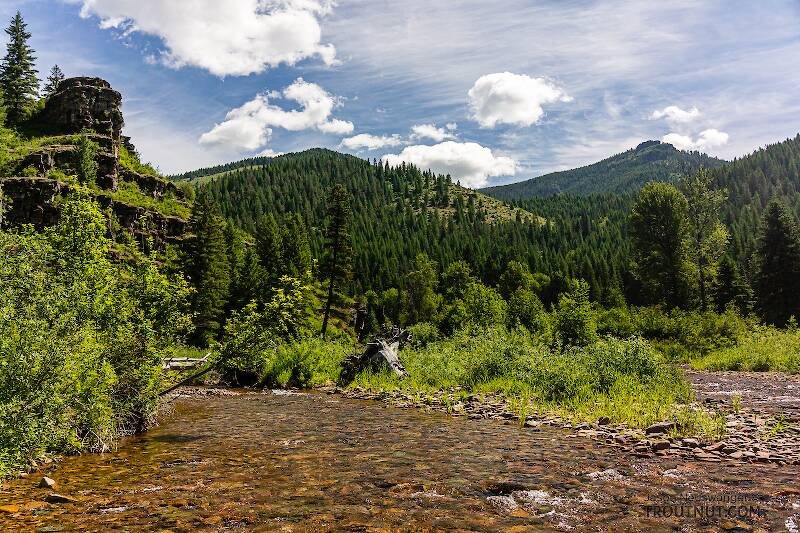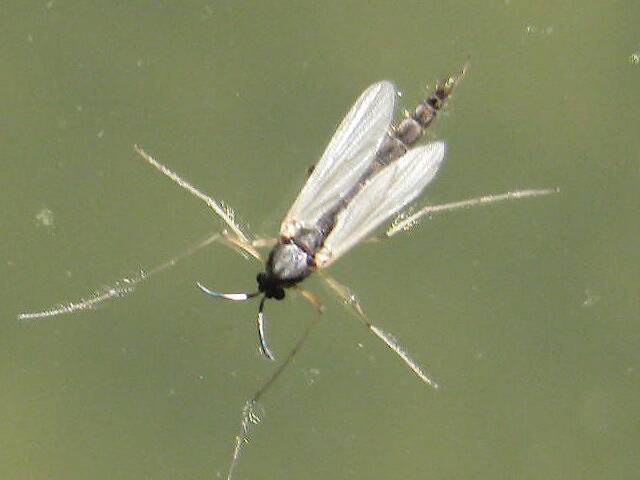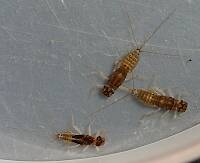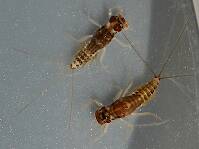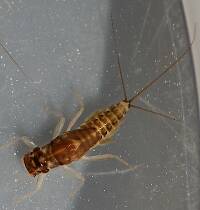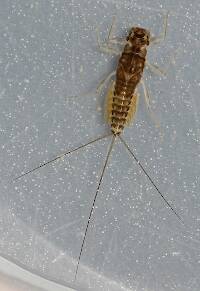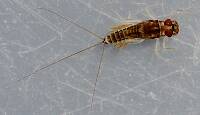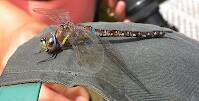
Hex Mayflies
Hexagenia limbata
The famous nocturnal Hex hatch of the Midwest (and a few other lucky locations) stirs to the surface mythically large brown trout that only touch streamers for the rest of the year.
Featured on the forum

This specimen appears to be of the same species as this one collected in the same spot two months earlier. The identification of both is tentative. This one suffered some physical damage before being photographed, too, so the colors aren't totally natural. I was mostly photographing it to test out some new camera setting idea, which worked really well for a couple of closeups.

Troutnut is a project started in 2003 by salmonid ecologist Jason "Troutnut" Neuswanger to help anglers and
fly tyers unabashedly embrace the entomological side of the sport. Learn more about Troutnut or
support the project for an enhanced experience here.
Entoman on Jan 28, 2013January 28th, 2013, 4:52 pm EST
Luke, you mentioned there's so much we don't know in the fractercula thread. From an angling importance standpoint, which genus/species groups seem to have the most work needed? Which ones have issues that interest you the most? Entoman
There are plenty of folks who spend more time on the water than me these days, and that experience and observation is valuable.
What part of the world are you asking about? Konchu
"It's not that I find fishing so important, it's just that I find all other endeavors of Man equally unimportant... And not nearly as much fun!" Robert Traver, Anatomy of a Fisherman
Entoman on Jan 28, 2013January 28th, 2013, 5:03 pm EST
From an "angling importance" standpoint I meant the ones most likely to intersect with trout and anglers in numbers that may make them important. I know that's a pretty wide swath and certainly open to different interpretation based on anecdotal experience. What I was really trying to do was narrow the discussion at least a little by excluding those not found in trout country or if they are found, that they are in such tiny numbers that interaction with both trout and anglers would probably be highly improbable.
It was more of a general "broad brush" question not limited to any geographic region other than trout country in North America excluding Mexico. You've mentioned some interesting work in progress involving ephemerellids before and some of your past comments mentioning heptageniids come to mind as well. Baetids? I assume they will always be difficult... I guess what I'm asking is where you see us now and where you see things going in the future.
It was more of a general "broad brush" question not limited to any geographic region other than trout country in North America excluding Mexico. You've mentioned some interesting work in progress involving ephemerellids before and some of your past comments mentioning heptageniids come to mind as well. Baetids? I assume they will always be difficult... I guess what I'm asking is where you see us now and where you see things going in the future.
"It's not that I find fishing so important, it's just that I find all other endeavors of Man equally unimportant... And not nearly as much fun!" Robert Traver, Anatomy of a Fisherman
Konchu on Jan 28, 2013January 28th, 2013, 7:24 pm EST
Wow. Let me get some batteries for my crystal ball, and then I will get back to you on that. Seriously, I need some time to think about that. If nothing else, I will venture to say I've learned to expect to find interesting things in unexpected places. New diversity in usually boring habitats, new taxa in waters others scoff at or turn down the chance to collect, and new discoveries in "well-studied" groups are all things that no longer surprise me. That big barcoding paper we put out awhile back lays out a bunch of the areas of needed inquiry. I think many genera need a good look, including the common genera Baetis, Ephemerella, Maccaffertium and Stenacron, just to name four off the top of my head. New species and reinstated species probably both remain to be discovered. Paraleptophlebia larvae need reared to the male adult stage, especially in the West (USA/Canada). Rearing in general can confirm or refute metamorphic stage association hypotheses. Certain habitats need exploring, especially lakes & ponds and temporary streams. Globally, terribly little is known from Africa and Southeast Asia. Much remains to be discovered in South America. Going back to what I said before, we still have many surprises waiting here in North America. We all just have to look.
Entoman on Jan 29, 2013January 29th, 2013, 12:06 pm EST
Interesting Luke, even with a dim ball. Can't wait to read what you have to say when the batteries get loaded.:)
As an outsider looking in with limited understanding, it seems that the general trend is a shrinking of species (excluding new finds) and a rapid expansion of genera and even familes. Do you see this trend continuing? Also, why the tendency to "lump" into species but "split" when looking higher up the tree in the first place? Case in Point: The family Ephemerellidae has seen a rapid expansion of genera while on the other hand species like Ephemerella excrucians (Pale Morning Dun) and invaria (Light Hendrickson) have had a broad brush used to sweep a lot of highly divergent forms into the same box. Are we likely to see similar reinstatements with them as recently occured with the eastern Drunella species that went through a similar "lumping" phase? Perhaps even new species? It seems people are often coming across specimens that don't fit well with published descriptions.
...and new discoveries in "well-studied" groups are all things that no longer surprise me. That big barcoding paper we put out awhile back lays out a bunch of the areas of needed inquiry. I think many genera need a good look, including the common genera ..., Ephemerella...
As an outsider looking in with limited understanding, it seems that the general trend is a shrinking of species (excluding new finds) and a rapid expansion of genera and even familes. Do you see this trend continuing? Also, why the tendency to "lump" into species but "split" when looking higher up the tree in the first place? Case in Point: The family Ephemerellidae has seen a rapid expansion of genera while on the other hand species like Ephemerella excrucians (Pale Morning Dun) and invaria (Light Hendrickson) have had a broad brush used to sweep a lot of highly divergent forms into the same box. Are we likely to see similar reinstatements with them as recently occured with the eastern Drunella species that went through a similar "lumping" phase? Perhaps even new species? It seems people are often coming across specimens that don't fit well with published descriptions.
"It's not that I find fishing so important, it's just that I find all other endeavors of Man equally unimportant... And not nearly as much fun!" Robert Traver, Anatomy of a Fisherman
Falsifly on Jan 29, 2013January 29th, 2013, 12:42 pm EST
It seems people are often coming across specimens that don't fit well with published descriptions.
And so seems the way of many fly tiers' too.
Falsifly
When asked what I just caught that monster on I showed him. He put on his magnifiers and said, "I can't believe they can see that."
When asked what I just caught that monster on I showed him. He put on his magnifiers and said, "I can't believe they can see that."
Quick Reply
Related Discussions
Topic
Replies
Last Reply
18
Sep 15, 2014
by Oldredbarn
by Oldredbarn
6
Jan 4, 2010
by Konchu
by Konchu
2
Jun 16, 2008
by Konchu
by Konchu
3
Oct 30, 2009
by Doublezz105
by Doublezz105

